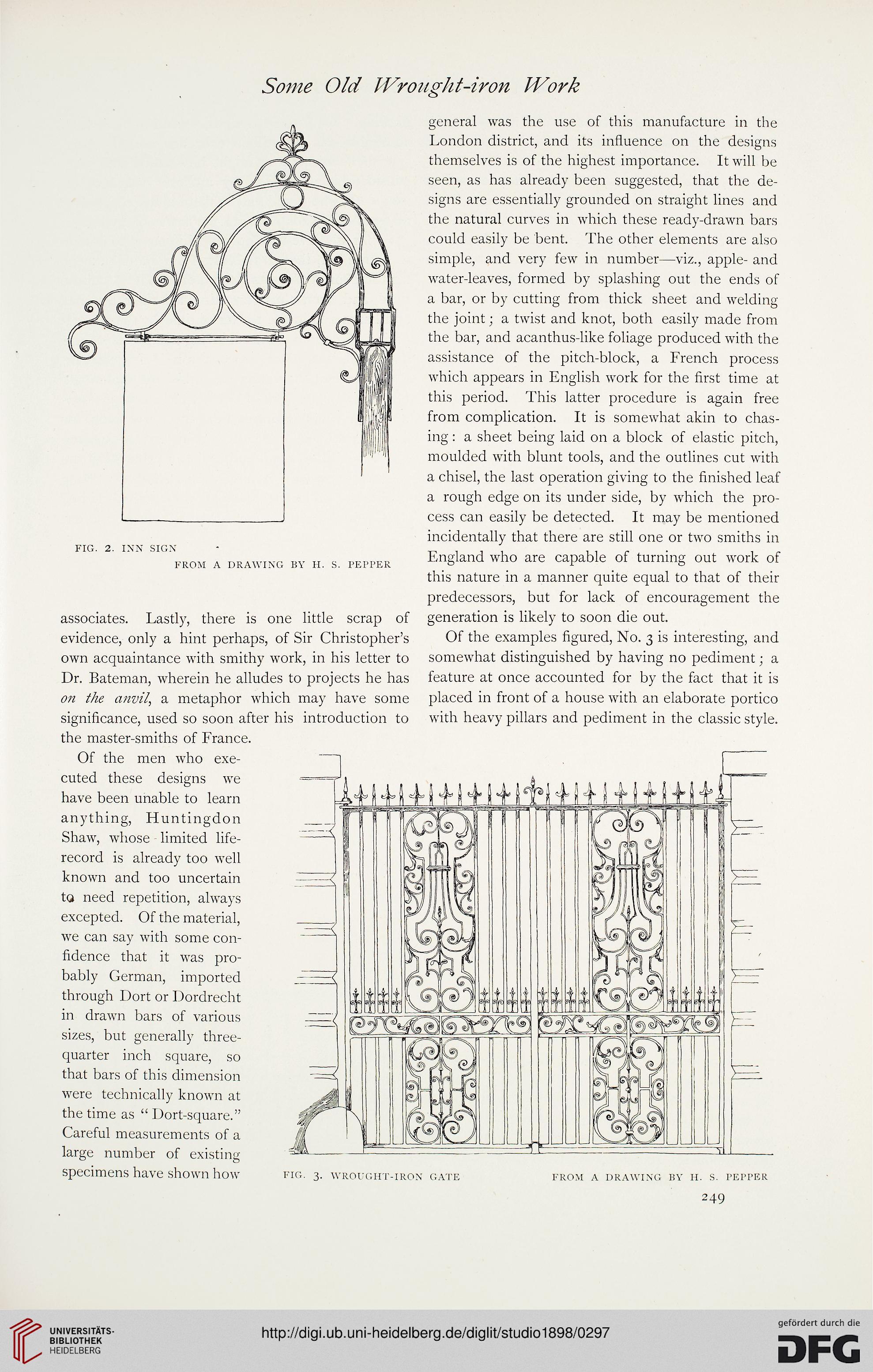Some Old IVrought-iron Work
fig. 2. inn sign
from a drawing by h. s. pepper
general was the use of this manufacture in the
London district, and its influence on the designs
themselves is of the highest importance. It will be
seen, as has already been suggested, that the de-
signs are essentially grounded on straight lines and
the natural curves in which these ready-drawn bars
could easily be bent. The other elements are also
simple, and very few in number—viz., apple- and
water-leaves, formed by splashing out the ends of
a bar, or by cutting from thick sheet and welding
the joint; a twist and knot, both easily made from
the bar, and acanthus-like foliage produced with the
assistance of the pitch-block, a French process
which appears in English work for the first time at
this period. This latter procedure is again free
from complication. It is somewhat akin to chas-
ing : a sheet being laid on a block of elastic pitch,
moulded with blunt tools, and the outlines cut with
a chisel, the last operation giving to the finished leaf
a rough edge on its under side, by which the pro-
cess can easily be detected. It may be mentioned
incidentally that there are still one or two smiths in
England who are capable of turning out work of
this nature in a manner quite equal to that of their
predecessors, but for lack of encouragement the
associates. Lastly, there is one little scrap of generation is likely to soon die out.
evidence, only a hint perhaps, of Sir Christopher's Of the examples figured, No. 3 is interesting, and
own acquaintance with smithy work, in his letter to somewhat distinguished by having no pediment; a
Dr. Bateman, wherein he alludes to projects he has feature at once accounted for by the fact that it is
on the anvil, a metaphor which may have some placed in front of a house with an elaborate portico
significance, used so soon after his introduction to with heavy pillars and pediment in the classic style,
the master-smiths of France.
Of the men who exe-
cuted these designs we
have been unable to learn
anything, Huntingdon
Shaw, whose limited life-
record is already too well
known and too uncertain
tQ need repetition, always
excepted. Of the material,
we can say with some con-
fidence that it was pro-
bably German, imported
through Dort or Dordrecht
in drawn bars of various
sizes, but generally three-
quarter inch square, so
that bars of this dimension
were technically known at
the time as " Dort-square."
Careful measurements of a
large number of existing
specimens have shown how fig. 3. wrought-iron gate from a drawing by 11. s. pepper
249
fig. 2. inn sign
from a drawing by h. s. pepper
general was the use of this manufacture in the
London district, and its influence on the designs
themselves is of the highest importance. It will be
seen, as has already been suggested, that the de-
signs are essentially grounded on straight lines and
the natural curves in which these ready-drawn bars
could easily be bent. The other elements are also
simple, and very few in number—viz., apple- and
water-leaves, formed by splashing out the ends of
a bar, or by cutting from thick sheet and welding
the joint; a twist and knot, both easily made from
the bar, and acanthus-like foliage produced with the
assistance of the pitch-block, a French process
which appears in English work for the first time at
this period. This latter procedure is again free
from complication. It is somewhat akin to chas-
ing : a sheet being laid on a block of elastic pitch,
moulded with blunt tools, and the outlines cut with
a chisel, the last operation giving to the finished leaf
a rough edge on its under side, by which the pro-
cess can easily be detected. It may be mentioned
incidentally that there are still one or two smiths in
England who are capable of turning out work of
this nature in a manner quite equal to that of their
predecessors, but for lack of encouragement the
associates. Lastly, there is one little scrap of generation is likely to soon die out.
evidence, only a hint perhaps, of Sir Christopher's Of the examples figured, No. 3 is interesting, and
own acquaintance with smithy work, in his letter to somewhat distinguished by having no pediment; a
Dr. Bateman, wherein he alludes to projects he has feature at once accounted for by the fact that it is
on the anvil, a metaphor which may have some placed in front of a house with an elaborate portico
significance, used so soon after his introduction to with heavy pillars and pediment in the classic style,
the master-smiths of France.
Of the men who exe-
cuted these designs we
have been unable to learn
anything, Huntingdon
Shaw, whose limited life-
record is already too well
known and too uncertain
tQ need repetition, always
excepted. Of the material,
we can say with some con-
fidence that it was pro-
bably German, imported
through Dort or Dordrecht
in drawn bars of various
sizes, but generally three-
quarter inch square, so
that bars of this dimension
were technically known at
the time as " Dort-square."
Careful measurements of a
large number of existing
specimens have shown how fig. 3. wrought-iron gate from a drawing by 11. s. pepper
249




